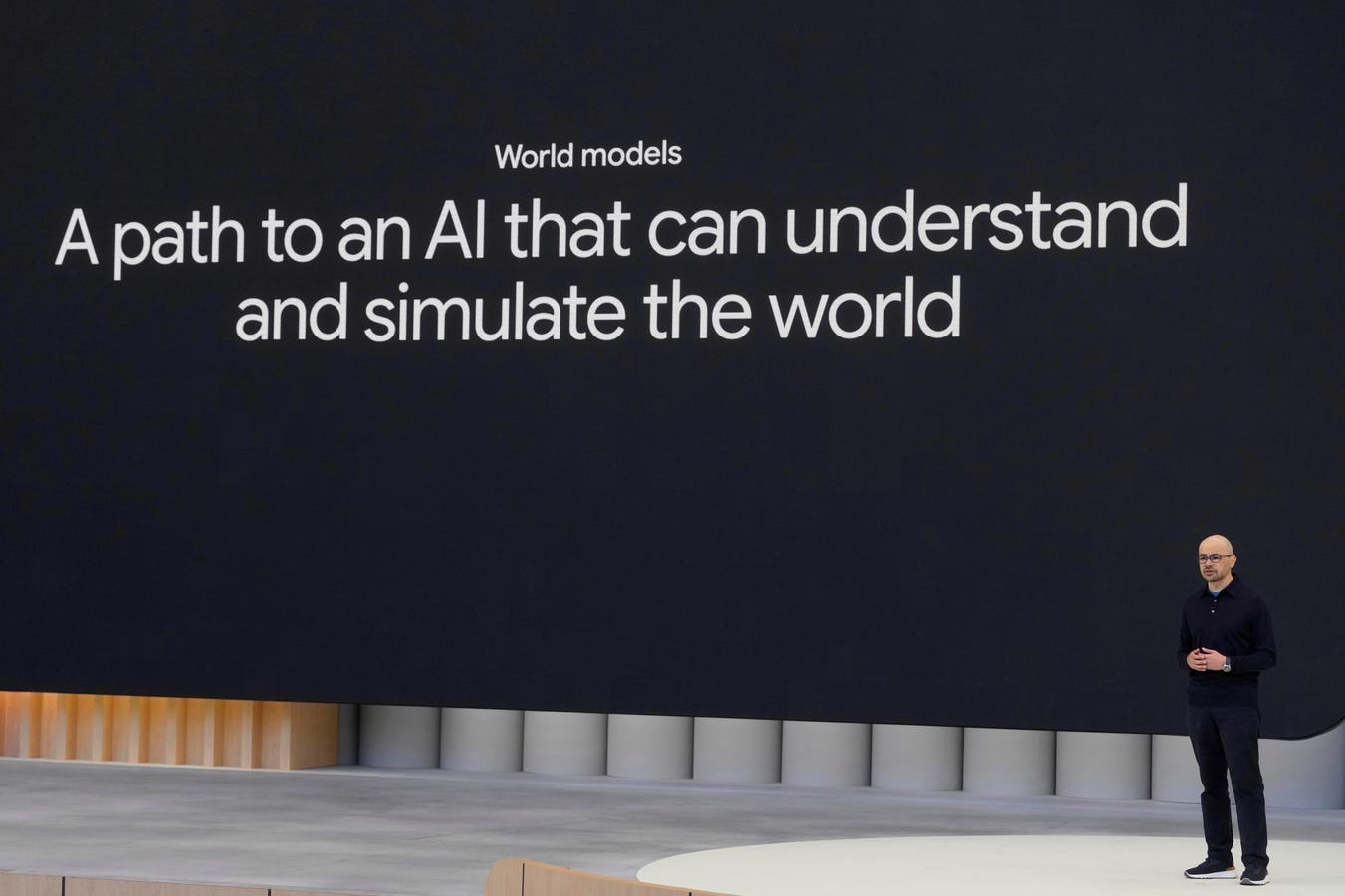Demis Hassabis, Co-Founder and CEO, Google DeepMind, speaks at a Google I/O event in Mountain View, … More
Monday, June 30th delivered a triple whammy of news that perfectly captures AI’s current state. Meta unveiled its Superintelligence Labs after spending $14.3 billion to invest in Scale AI and poach talent from OpenAI, Anthropic, Google and others. Microsoft claimed its AI diagnoses patients 4x better than doctors. And the White House launched an AI youth education pledge, acknowledging AI literacy is as essential as reading.
These weren’t isolated events. Over the past six months we’ve seen some of the most dramatic AI disruptions since ChatGPT’s debut in November 2022. If you zoom out, they’re symptoms of four converging AI forces reshaping at unprecedented speed every aspect of society from people to businesses to governments: compute, data, algorithms, and robotics (often referred to as “physical AI”). Compute costs have plummeted 25x, synthetic data is reducing AI training expenses, breakthroughs like DeepSeek along with model updates from OpenAI, Anthropic, xAI, and Google continue to push the limits of scaling laws, and humanoid robot pioneers such as Tesla (Optimus), Figure AI and Agility Robotics are preparing to commercialize physical AI-powered robots starting in late 2025. Progress in any one of these forces would be impressive on their own. When combined, these forces are amplifying each other to create unprecedented opportunities for prepared businesses and existential threats for the unprepared.
As we cross 2025’s midpoint, it’s time to assess what just happened and brace for what’s coming.
AI Force #1 • Compute: The Paradox of Plenty
Compute is the raw processing power driving AI – the brain power. The first half of 2025 revealed a paradox: while compute options multiplied, actual GPU availability remained critically constrained. NVIDIA’s Blackwell Ultra announcement promised 50% better performance at 25x less power—if you could get them. With 36-52 week lead times and allocation politics determining who gets chips, the “democratization” remains theoretical.
We’re seeing the rise of accelerated computing as GPU performance is growing 2x per year
While NVIDIA’s Project DIGITS offers $3,000 desktop AI, the real action stayed in data centers where Microsoft Azure’s 35% growth meant fierce competition for H100s and A100s. Google’s TPU v7 claims 24x better economics, but its hard to access them outside Google Cloud. Intel’s Gaudi 3 at $125,000 looks attractive until you realize the software ecosystem barely exists. The brutal truth: despite AMD’s quantization efforts and edge computing promises, if you need serious training compute in H1 2025, you’re either paying NVIDIA’s prices, waiting in line, or making do with inferior alternatives. DeepSeek’s $6 million miracle wasn’t about abundant compute – it was about doing more with less because they had no choice.
What’s next: Blackwell production ramps from 200,000 to 2 million units by December, finally breaking the GPU stranglehold. Expect large training cost reductions and mid-market companies achieving GPT-4 capabilities for under $10,000/month.
AI Force #2 • Data : The Insatiable Hunger
Data is the oxygen of AI. Without quality data, even the most sophisticated algorithms suffocate, making the difference between AI that demos well and AI that delivers measurable business value. The first half of 2025 marked data’s shift from volume obsession to quality management, especially as all publicly-available internet data has essentially already been ingested into LLMs, creating a scramble for new data sources.
Synthetic data – AI-generated information that mimics real-world patterns without containing actual user data – is a key part of AI’s growth story. The synthetic data market is expected to reach $3.7 billion by 2030, but most implementations remain basic data augmentation. Every player, both small and large, continue to search for more data. Just look at Meta’s $14.3 billion Scale AI investment – part “acqui-hire” for sure, but it was also for direct access to Scale’s data labeling expertise and access to enterprise data partnerships. As IP rights are being debated, a major ruling came when Anthropic’s copyright victory legitimized training on copyrighted material. The hunger for data is ravenous.
Scale AI is a key player in the AI data industry, specializing in data annotation and model … More
The last two data frontiers remain stubbornly out of reach. First-party enterprise data is locked behind corporate firewalls (containing decades of proprietary business intelligence), so every AI firm is now focused on how best to partner (and penetrate) the enterprise. The other source is real-world sensor data that’s critical for physical AI. While Tesla’s builds its humanoid robot fleet Optimus, it will benefit from the billions of miles of driving data that synthetic generation can’t replicate.
What’s next: The majority of major companies will adopt synthetic data strategies by December. The first AI model trained entirely on synthetic data will outperform human-trained models, ending the “data is the new oil” era. But the real battle shifts to enterprise data – expect aggressive partnerships and “data-for-compute” deals.
AI Force #3 • Algorithms : Surpassing Scaling Laws
If compute is brain power and data is oxygen, then algorithms are the neural pathways – the connections and patterns that determine how efficiently the brain uses oxygen to produce intelligence. And we are on the road to superintelligence – just read the essays from OpenAI’s Sam Altman or Anthropic’s Dario Amodei. The first half of 2025 shattered every assumption about scaling laws and compute requirements. DeepSeek’s R1 bombshell – reportedly achieving GPT-4 parity for $6 million versus $100+ million – wiped out $1 trillion dollars in market capitalization and sparked global panic back in January. However, by June the markets were back at new highs as the industry realized that this wasn’t just cost reduction, it was algorithmic innovation as they used mixture-of-experts, aggressive sparsity, and clever routing.
There have been 50 major model releases in just the first six months of 2025, with lots of different sizes, features, and use cases (see the table below).
50 major large language models have been released in the first six months of 2025
Open-weight models closed the gap with their closed-weight counterparts. In January 2024, the leading closed-weight model outperformed the top open-weight model by 8.04% on the Chatbot Arena Leaderboard, and by February 2025 this gap had narrowed to 1.70%. Claude 4 Opus hitting 72.5% on SWE-bench while coding autonomously for 7+ hours showed reasoning, not size, wins. Google’s Gemini 2.5 Flash at 742 tokens/second redefined inference economics. By June, enterprise costs plummeted from $10,000 to sub-$1,000 monthly for equivalent performance. The truth that every LLM researcher knows is that most top models are now within the range of +/- 5% of each other, so we’re waiting for the next step-function in innovation. Some of the focus is shifting from model training to system design – companies seeing 60% higher ROI focus on prompt engineering, RAG implementation, and workflow integration. While the “bigger is better” model was questioned in H125, what is becoming clear is that there will be many flavors for lots of different use cases.
What’s next: The “bigger is better” era ends. Agentic AI takes over – expect many companies to start having customer service handled by autonomous agents and perhaps whole departments being run entirely by AI. Salesforce already reports 30-50% of work done by AI.
AI Force #4: Robotics : From Labs to Loading Docks
Robotics and physical AI represent the final frontier in business transformation, with over 4 million industrial robots now operating globally and installations growing at 7% annually. Tesla aims to produce “several thousand” Optimus humanoid robots in 2025 for internal use, targeting sub-$30,000 pricing that could revolutionize labor economics. Figure AI’s $39.5 billion valuation after raising $1.5 billion demonstrates investor confidence in embodied intelligence, while Agility Robotics’ Digit achieved the first commercial humanoid deployment at GXO Logistics.
Figure Unveils Next-Gen Conversational Humanoid Robot With 3x AI Computing for Fully Autonomous … More
The business case has shifted from future promise to present reality. Industrial automation delivers 12-24 month payback periods for large-scale deployments, with robots operating at $0.75/hour versus human labor costs. Manufacturing labor costs drop 20-30% with robotic automation while productivity increases 150% in equipment manufacturing. Agricultural drones, numbering 620,000 worldwide and growing 40% annually, exemplify how physical AI transforms traditional industries through precision and scale.
Breakthrough capabilities in 2025 include 24+ hour autonomous operation with 99%+ reliability, multimodal perception combining vision and touch, and natural language control eliminating specialized programming. Yet adoption barriers remain: battery limitations, integration complexity with legacy systems, and a critical skills gap in robotics operation. The winners embrace Robotics-as-a-Service models to reduce capital requirements, invest in workforce training for human-robot collaboration, and pilot solutions in controlled environments before scaling.
What’s next: The first 10,000+ humanoid deployment hits warehouses. China deploys over a million service robots. We start to see the first “dark factories” operating 24/7 without humans. Robot-as-a-Service becomes a new growth market as companies offload capital expenditures.
Business leaders must act on converging opportunities
The four forces create immediate risks and opportunities for today’s business leaders.
First, reassess infrastructure investments given that algorithmic advances can deliver 95% cost savings—your planned GPU purchases may already be obsolete.
Second, implement edge computing to reduce cloud dependencies by 60-90% while improving response times and data sovereignty.
Third, embrace synthetic data to accelerate AI development while maintaining privacy compliance, joining the 60% of projects already benefiting from this approach.
Medium-term strategies should focus on building AI implementation expertise rather than model development capabilities, as the 1.7% performance gap between open and proprietary models makes execution more important than selection. Develop hybrid human-robot workflows in operations, targeting the proven 2-year ROI rather than full automation fantasies. Create comprehensive data governance frameworks that treat information as a strategic asset, enabling the multimodal integration that drives next-generation business models.
For long-term positioning, prepare for the algorithmic efficiency paradigm where smaller, optimized models outperform larger ones, making capital-intensive infrastructure strategies obsolete. Build partnerships that provide access to specialized capabilities rather than attempting to develop everything internally. Most critically, invest in workforce transformation. The organizations lacking sufficient AI talent will become exposed and lose out to those who develop these capabilities.
The convergence of plummeting compute costs, synthetic data accessibility, algorithmic breakthroughs, and practical robotics has created a unique window for business transformation. Organizations that recognize these forces aren’t developing independently but amplifying each other will capture disproportionate value. The question isn’t whether to embrace AI-driven transformation, but whether you’ll lead it or be disrupted by competitors who do. The tools are accessible, the economics are proven, and the early movers are already capturing market share. What remains is execution and the window for strategic advantage is narrowing rapidly.









